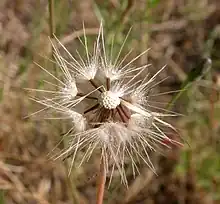| Hypochaeris glabra | |
|---|---|
 | |
| Group of achenes with barbs | |
| Scientific classification | |
| Kingdom: | Plantae |
| Clade: | Tracheophytes |
| Clade: | Angiosperms |
| Clade: | Eudicots |
| Clade: | Asterids |
| Order: | Asterales |
| Family: | Asteraceae |
| Genus: | Hypochaeris |
| Species: | H. glabra |
| Binomial name | |
| Hypochaeris glabra | |
| Synonyms[1] | |
|
Synonymy
| |
Hypochaeris glabra is a species of flowering plant in the tribe Cichorieae within the family Asteraceae known by the common name smooth cat's ear. It is native to Europe,[2] North Africa, and the Middle East but it can be found on other continents where it is an introduced species and a widespread weed. It has become widespread in Africa, southern and southeastern Asia, Australia, and parts of the Americas (especially California).[3][4][5][6]
Hypochaeris glabra is an annual herb growing a small taproot, a basal rosette of leaves, and one or more thin stems 10–40 cm (4–16 in) tall. The leaves are 2–10 cm (3⁄4–4 in) long, smooth along the edges or with small lobes, and green in color, sometimes with a purplish tint near the veins. Atop the thin, naked stems are flower heads with small overlapping purple-tipped phyllaries and bright yellow ray florets. The fruit is a cylindrical achene with a white pappus almost 1 cm (3⁄8 in) long.[7]
References
- ↑ The Plant List, Hypochaeris glabra L.
- ↑ Altervista Flora Italiana, Hypochaeris glabra L. includes photos and European distribution map
- ↑ Biota of North America Program 2014 county distribution map
- ↑ Calflora taxon report, University of California, Hypochaeris glabra L., Smooth Cats ear, smooth cat's ear, smooth catsear
- ↑ Flora of China, Hypochaeris glabra Linnaeus, 1753. 光猫儿菊 guang mao er ju
- ↑ Atlas of Living Australia
- ↑ Flora of North America, Hypochaeris glabra Linnaeus, 1753. Smooth cat’s ear
External links
- Jepson Manual Treatment, University of California
- C.Michael Hogan ed. 2010. “Hypochaeris glabra”. Encyclopedia of Life
- United States Department of Agriculture Plants Profile
- Calphotos Photo gallery, University of California
- photo of herbarium specimen at Missouri Botanical Garden